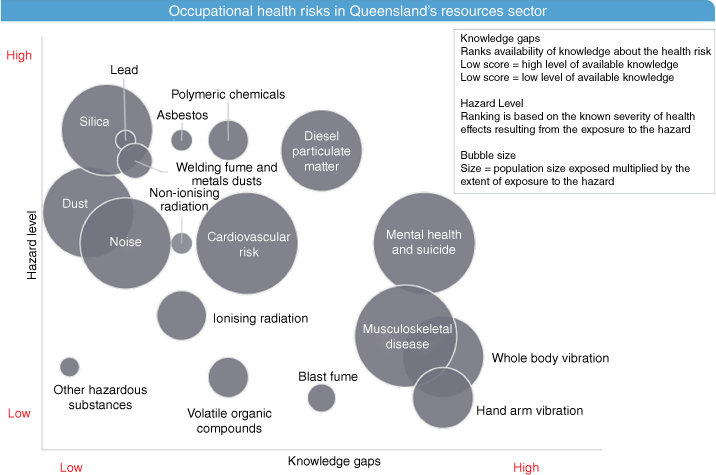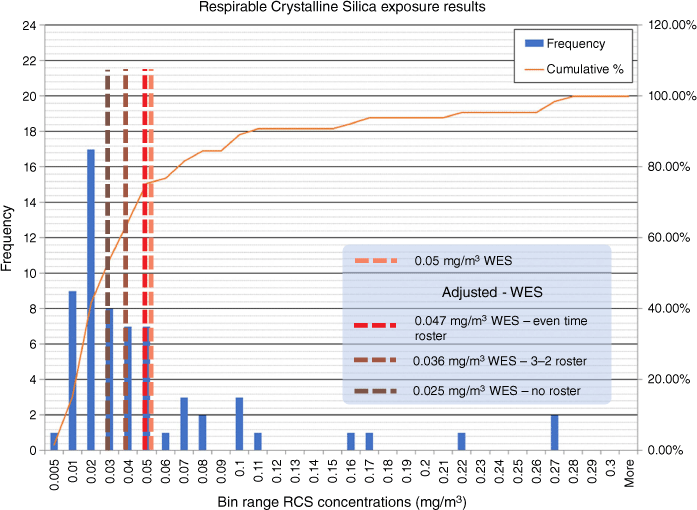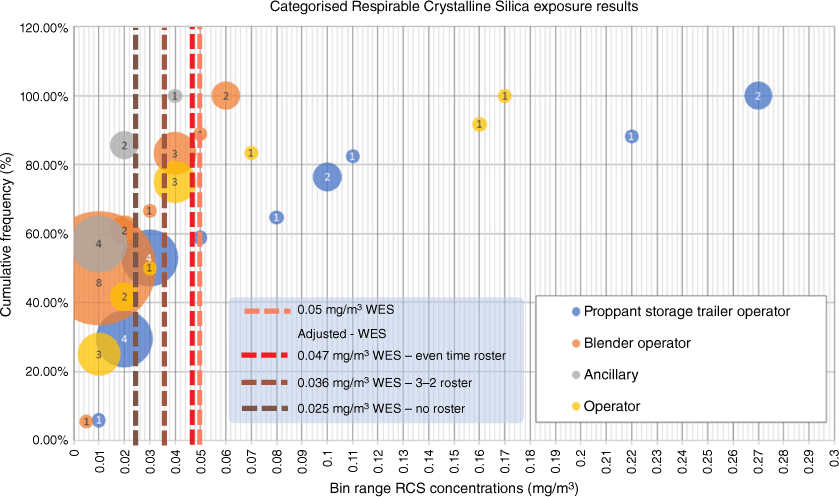Proppant powder – the protection and the pain – lurking hazards of silicosis
Chris Barrand A * , Radika Lucas A and Anne Nissen BA Resources Safety and Health Queensland, Petroleum Gas Inspectorate, Brisbane, Qld, Australia.
B Resources Safety and Health Queensland, Safety in Mines Testing and Research Station, Brisbane, Qld, Australia.
The APPEA Journal 63 S286-S290 https://doi.org/10.1071/AJ22145
Accepted: 7 March 2023 Published: 11 May 2023
© 2023 The Author(s) (or their employer(s)). Published by CSIRO Publishing on behalf of APPEA. This is an open access article distributed under the Creative Commons Attribution-NonCommercial-NoDerivatives 4.0 International License (CC BY-NC-ND)
Abstract
Resources Safety and Health Queensland (RSHQ) is the independent regulator for safety and health in Queensland’s resources sector. The Petroleum and Gas Inspectorate (the Inspectorate) administers safety and health regulation for the petroleum and gas industry. RSHQ uses a risk-based and data-driven approach to pursue its vision of zero serious harm for resource sector workers. In Queensland, on average, there are 200 fraccing operations conducted annually on oil and gas wells. For each fraccing operation, up to 450 tonnes of proppant may be used with an estimated 16 340–23 800 tonnes pumped annually. The majority of proppant used in Queensland is refined sand and is a potential source of exposure to respirable crystalline silica (RCS) during these operations. In 2020 safe exposure levels for RCS was halved from 0.1 to 0.05 mg/m3. Exposure to levels above this threshold may increase the risk of adverse health outcomes, such as respiratory diseases including silicosis, chronic obstructive pulmonary disease and lung cancer. These diseases are progressive, and typically can take at least 10 years of prolonged exposure to develop symptoms. All silica dust-related diseases are preventable through using effective controls. This paper outlines a study on RCS exposure levels in hydraulic fracturing operations in Queensland. The objective of the study was to understand the adequacy of the current controls in place to protect workers against exposure to RCS following the reduction of the safe exposure levels.
Keywords: fraccing, occupational health, oil and gas workers, RCS, respirable crystalline silica, silica, WES, worker exposure oil and gas, workplace exposure standards.
Introduction
The Petroleum and Gas Inspectorate (the Inspectorate) administers safety and health regulation for the petroleum and gas industry. The re-emergence of mine dust lung disease in Queensland’s mining industry demonstrates the need for health and safety programs to include a focus on preventing disease and other health harms.
Commissioned by Resources Safety and Health Queensland (RSHQ), Ernst and Young and the University of Queensland conducted a baseline review of occupational health risks relevant to the resources sector, including controls and monitoring strategies.
Silica exposure was considered a significant health risk for workers in Queensland’s resources sectors, as shown in Fig. 1 (Ernst and Young 2021). Prolonged exposure to respirable crystalline silica (RCS) particulates can lead to respiratory diseases, with varying severity depending on exposure, including silicosis, chronic obstructive pulmonary disease and lung cancer. There is no cure for silicosis, however, all silica dust-related diseases are preventable through using effective controls (Safe Work Australia 2021).
Evaluation of occupational health risk across Queensland’s resources sectors (Ernst and Young 2021).

Hydraulic fracture stimulation treatment (fraccing) was identified as a primary focus for the project. Workers conducting frac operations routinely interact with refined sand, a frequently used proppant. Contact with proppant presents potential exposure to RCS for oil and gas workers. In Queensland, on average, there are 200 fraccing operations conducted annually on oil and gas wells. For each fraccing operation, up to 450 tonnes of proppant may be used with an estimated 16 340–23 800 tonnes pumped into wells annually (GSQ 2022).
In 2018 the Inspectorate commenced a proactive project with another RSHQ division, Safety in Mines Testing and Research Station (SIMTARS). The project sought to improve industry and regulator understanding about oil and gas worker exposure to health risks associated with respirable dust and silica.
The objective of this study was to understand the exposure potential of workers to respirable dust and silica and effectiveness of implemented controls to protect workers. The study commenced in 2018 and engaged two hydraulic fracturing service providers based on their large-scale Queensland operations. The study consisted of four site surveys of fraccing equipment, with the preliminary results provided to each participant mid-2019. Additional controls were implemented by participants in response to preliminary results provided and follow-up surveys were completed in mid-2020.
Methodology
Site surveys incorporated data about fraccing operations, routine operations, respirable protective equipment (RPE) and job safety assessments and pre-job risk assessments. The study involved static monitoring, real-time aerosol monitoring and individual worker monitoring. In addition to the monitoring program, assessments were made during the site surveys on potential exposure hazards and controls.
Survey results were compared against the national workplace exposure standards (WESs) for workplace contaminants as published by SWA (Safe Work Australia 2022).
The thresholds used for comparison were:
0.05 mg/m3 – the SWA WES for RCS.
0.02 mg/m3 – the ‘recommended’ threshold for RCS – initially proposed by SWA as the standard WES based on scientific evidence that silica dust exposure levels above this would lead to adverse health effects (Safe Work Australia 2019). This threshold has not yet been adopted by SWA following industry feedback about practical challenges in measuring and monitoring.
Adjusted WES thresholds are based on the shift time worked on a 12-h work day with the following roster scenarios. The Brief and Scala adjustment model has been used for this project:
Adjusted thresholds were made in accordance with SWA guidelines (Safe Work Australia 2013) and resolved the issue of the RCS WES being based on a 40 hour work week.
Static monitoring
Static monitoring was conducted to establish a baseline of exposure levels experienced throughout the work site. The information gathered from these monitoring locations would help to validate the pre-existing exclusion zones and RPE requirements of the work sites.
Real-time aerosol monitoring
Real-time aerosol monitoring was conducted during bulk reloading of the proppant storage trailer, pumping of fraccing stages and rig-up and rig-down activities. This monitoring provided indicative insight into instantaneous exposure concentrations which improved understanding about exposure rates during different job tasks. TSI’s Personal Aerosol Monitor AM510 was used to conduct the measurements.
Individual worker monitoring
Work areas with high potential exposure to RCS were identified by reviewing job safety assessments and pre-job risk assessments. Fifty-five workers were selected for monitoring based on their interactions with identified high potential exposure work areas across four sites.
Monitored workers wore sampling equipment that continuously captured samples of respirable particulates during the monitoring period. Sampling and analysis were conducted as per requirements of AS 2985 (Standards Australia 2009) and analysis of free quartz was conducted in accordance with requirements of the National Health and Medical Research Council (NHMRC 1984).
Results and discussion
Static monitoring
Results for static monitoring confirmed the highest RCS exposure risk as the transfer point between the proppant trailer and the blender. Results for this work area were more than twice the 0.05 mg/m3 WES threshold. Furthermore, the blender platform and control panel work areas experienced an RCS concentration equivalent to the maximum ‘recommended’ level, despite their distance from the transfer point.
Real-time aerosol monitoring
Results of real-time aerosol monitoring validated static monitoring data and provided insight into potential exposure for different worker activities during changing environmental conditions.
Individual worker monitoring
Results of individual worker monitoring as shown in Figs 2, 3 provided insight into overall population exposure, RCS exposure concentrations, and categorisation of high-risk workers. Survey data of the 55 workers monitored confirmed:
strong correlation between worker exposure levels monitored and proximity of the worker to the high-exposure sites;
short-term high-exposure periods increased overall exposure levels significantly for individual workers when comparing operator and ancillary worker results;
results for workers in the ancillary category who were not required to wear RPE were near the range of adjusted WES thresholds;
25% of workers experienced RCS exposure above the unadjusted SWA WES threshold of 0.05 mg/m3; and
60% of workers experienced exposure above the ‘recommended’ 0.02 mg/m3 threshold level.
The adjustment of the threshold to various crew rotations for workers surveyed confirmed that workers operating in a ‘3 weeks on 2 weeks off’ crew rotation compared to the standard WES 40 h work week experienced a 28% reduction in WES threshold of 0.05 mg/m3.
Results are presented in Fig. 3 as a modified histogram of the sampling results for each category. The size of each bubble represents the number of results within the bin range of the RCS exposure concentration. The location of bubbles is determined by the cumulative frequency of results within the bin range of the RCS exposure concentration. Adjusted WES thresholds are presented for reference.
Existing controls
Administrative controls were used by the participating fraccing operators prior to the survey. RPE and exclusion zones were used to mitigate worker exposure to RCS.
Post-survey controls
The controls implemented post survey were the addition of higher-order engineering controls and strengthening of the pre-existing administrative controls. Engineering controls included installation of shrouding and a misting system at the proppant transfer points to suppress dust. In addition, remote controls were installed to allow control of the proppant trailer outside the high-exposure zone. Existing controls were strengthened by expanding exclusion zones, using enhanced air purifying respirators and, mandatory RPE requirements for additional work areas.
Participating service providers have commenced an employee monitoring program (RSHQ 2022) to evaluate the effectiveness of implemented controls.
Conclusions
The Inspectorate in conjunction with the expertise of SIMTARs has improved the understanding and awareness of RCS exposure levels for oil and gas workers during fraccing operations. The project validated the extent of previously identified high-exposure locations within fraccing operations and strengthened controls for reducing exposure levels for oil and gas workers.
The project also highlighted the impact of worker shift management on WES thresholds. It is critical for the oil and gas industry to understand how WES thresholds can be significantly reduced due to over cycle shifts or extended shifts.
Furthermore, monitoring results identified that workers not in the vicinity of the high-exposure sites were registering readings close to the ‘recommended’ WES threshold. It is recommended that further investigation into the causes of this be considered in future studies of RCS and dust exposure in the oil and gas sector.
The Inspectorate continues to monitor the current and future implemented controls of the service providers as part of the proactive regulatory compliance assurance program.
Acknowledgements
Special thanks to the Chief Inspector Bill Date for his contribution to the conceptualisation of the study. The authors wish to thank those participants in the study SLB and Halliburton. The authors wish to thank Liz Grolimund for her effort in the review process. The authors wish to extend a special thanks to Cecily Coleman for her efforts in the review and editing process.
References
Ernst and Young (2021) Baseline Review of Occupational Health Risks Report. (Resources Safety and Health Queensland)GSQ (2022) Estimates made based on data samples taken from the geological survey Queensland data portal public and confidential. Available at https://geoscience.data.qld.gov.au/
NHMRC (1984) ‘Methods for Measurement for Quartz in Respirable Airborne Dust by Infrared Spectroscopy and x-ray Diffractometry.’ (National Health and Medical Research Council)
RSHQ (2022) ‘Coal Mine Workers’ Health Scheme.’ (Resources Safety and Health Queensland)
Safe Work Australia (2013) ‘Guidance on the Interpretation of Workplace Exposure Standards for Airborne Contaminants.’ (Safe Work Australia)
Safe Work Australia (2019) ‘Draft Evaluation Report: Silica, Crystalline (Respirable Dust), Safe Work.’ (Safe Work Australia)
Safe Work Australia (2021) ‘Managing the Risks of Respirable Crystalline Silica from Engineered Stone in the Workplace Code of Practice.’ (Safe Work Australia)
Safe Work Australia (2022) ‘Workplace Exposure Standards for Airborne Contaminants.’ (Safe Work Australia)
Standards Australia (2009) ‘Workplace Atmospheres—Method for Sampling and Gravimetric Determination of Respirable Dust’. AS 2985:2009. (Standards Australia)

Chris Barrand was appointed Executive Petroleum Engineer (Well Operations), RSHQ in July 2022. Chris has 16 years’ experience in upstream oil and gas operations in Australia and Africa. Prior to joining RSHQ Chris held roles in both operator and service providers, spanning from Senior Drilling and Completions Engineer to Completions Business Unit Manager. Chris holds a Bachelors in Engineering (Petroleum Engineering) and is an active member of SPE (Society of Petroleum Engineers) and currently holds the role of Secretary for the SPE Queensland Chapter. |

Radika Lucas is a Chemical Engineer with 20 years of experience in the oil and gas industry spanning across upstream, downstream, onshore, and offshore operations. Radika has a strong commitment to worker safety, operations, and risk management and has always aspired to a ‘zero serious harm’ outcome in all roles she has undertaken. It is this shared vision that has led her to join the Petroleum and Gas Inspectorate at RSHQ, as the Deputy Chief Inspector. In addition to her commitment to improve the safety and health of Queensland gas sector workers, Radika is also an avid masters track and field competitor and a mother of two. |

Anne Nissen currently holds the position of Senior Occupational Hygienist at SIMTARs within RSHQ. Anne has completed a Master of Science (Occupational Hygiene Practice) post graduate degree and is a Certified Occupational Hygienist (COH®) through the AIOH. She has spent the past 10 years working as a Hygiene Consultant for the Queensland resources sector conducting numerous health risk assessments and sampling programs. |




